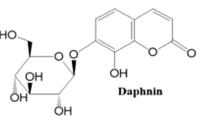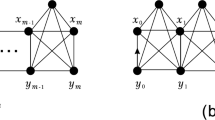Abstract
The study contains a deductive search for the principal monocyclic substructures determining different importances (weights) of separate Kekulè valence structures of phenylenes and their congeners. Individual Kekulè structures are modelled as continuous conjugated systems consisting of uniform double (C=C) bonds connected by uniform single (C–C) bonds, the latter being substantially weaker as compared to the former. The relevant total \(\pi\)-electron energies are shown to offer an adequate criterion for ordering of the structures concerned according to their weights. These energies, in turn, are derived in the form of power series with respect to the small resonance parameter of C–C bonds. Analysis of expressions for separate members of this series shows that the cyclobutadienoid rings (if any) are the most important destabilizing contributors to the energy of the given structure, whereas the benzenoid rings and cycles like 3,4-dimethylene cyclobutene take the second place (their increments are stabilizing and destabilizing, respectively). Additivity and transferability of the above-enumerated contributions to energies of Kekulè valence structures also are among the conclusions. These results provide us with an extension of the classical Fries rule to non-benzenoid hydrocarbons having four-atomic rings. Specific examples of the given class of compounds are considered in a detail, viz. biphenylene, [3]phenylene, as well as benzo- and naphthocyclobutenes. The relation of the approach applied to the theory of conjugated circuits also is discussed.
Graphical abstract






Similar content being viewed by others
References
Cyvin SJ, Gutman I (1988) Kekulè structures of benzenoid hydrocarbons. Springer, Berlin
Randić M, Plavsić D, Trinajstić N (1991) Struct Chem 2:543
Randić M (2003) Chem Rev 103:3449
Herndon WC (1974) J Chem Educ 51:10
Cooper D (2002) Valence bond theory. Elsevier, Amsterdam
Klein DJ, Trinajstić N (1990) Valence bond theory and chemical structure. Elsevier, Amsterdam
Rogers KM, Fowler PW (2001) J Chem Soc Perkin Trans 2:18
Ciesielski A, Krygowski TM, Cyranski MK (2010) Symmetry 2:1390
Randić M (2004) J Chem Inf Comput Sci 44:365
Fries K (1927) J Liebig Ann Chem 454:121
Fries K, Walter R, Schilling K (1935) J Liebig Ann Chem 516:248
Randić M (1961) J Chem Phys 34:693
Heiberg-Andersen H, Skjeltorp AT (2005) J Math Chem 38:589
Sedlar J, Andelić I, Gutman I, Vukičević D, Graovać A (2006) Chem Phys Lett 427:418
Dewar MJS, Longuet-Higgins HC (1952) Proc Roy Soc A 214:428
Trinajstić N (1977) In: Segal GA (ed) Semiempirical methods of electronic structure calculations, Part A, Techniques. Plenum Press, New York
Klein DJ, Randić M (1987) J Comput Chem 8:516
Graovać A, Gutman I, Randić M, Trinajstić N (1973) J Am Chem Soc 95:6267
Graovać A, Gutman I, Randić M, Trinajstić N (1978) Coll Czech Chem Commun 43:1375
El-Basil (1982) Int J Quant Chem 21:771
El-Basil (1982) Int J Quant Chem 21:779
El-Basil (1982) Int J Quant Chem 21:793
Havenith RWA, Van Lenthe JH, Dijkstra F, Jenneskens LW (2001) J Phys Chem A 105:3838
Krygowski TM, Anulewicz R, Kruszewski J (1983) Acta Crystallogr Sect B Struct Sci 39:732
Krygowski TM, Cyranski M (1997) In: Hargittai M, Hargittai I (eds) Advances in molecular structure research. JAI Press, London
Ciesielski A, Krygowski TM, Cyranski M, Balaban A (2011) Phys Chem Chem Phys 13:3737
Clar E (1972) The aromatic sextet. Wiley & Sons, London
Sola M (2013) Forty years of Clar’s aromatic π-sextet rule. Front Chem. https://doi.org/10.3389/fchem.2013.00022
Klein DJ, Trinajstić N (1989) Pure Appl Chem 61:2107
Klein DJ (1990) J Chem Educ 67:633
Gineityte V (2014) MATCH Commun Math Comput Chem 72:39
Gineityte V (2002) J Mol Struct (Theochem) 585:15
Gineityte V (2013) Int J Chem Model 5:99
Gineityte V (2016) Monatsh Chem 147:1303
Malrieu JP, Gicquel M, Fowler PW, Lepetit C, Heully JL, Chauvin R (2008) J Phys Chem A 112:13203
Vollhardt KPC, Mohler DL (1996) In: Halton B (ed) Advances in strain in organic chemistry, vol 5. JAI Press, London
Balaban AT, Vollhardt KPC (2011) Open Org Chem J 5(Suppl 1-M8):117
Schulman JM, Disch RL (1993) J Am Chem Soc 115:11153
Cava MP, Shirley RL, Erickson BW (1962) J Org Chem 27:755
Crawford JL, Marshi RE (1973) Acta Crystallogr B 29:1238
Cava MP, Deana AA, Muth K (1960) J Am Chem Soc 82:2524
Lawrence JL, MacDonald SGG (1969) Acta Crystallogr B 25:978
Gutman I, Ashrafi AR (2008) MATCH Commun Math Comput Chem 60:135
Furtula B, Gutman I (2008) Indian J Chem 47A:220
Coulson CA, O’Leary B, Mallion RB (1978) Hűckel theory for organic chemists. Academic Press, London
Yates K (1978) Hűckel molecular orbital theory. Academic Press, New York
Gutman I (2005) Monatsh Chem 136:1055
Fishtik I (2011) J Phys Org Chem 24:263
Mitchell RH, Iyer VS (1996) J Am Chem Soc 118:2903
Randić M (2011) Open Org Chem J 5(Suppl 1-M2):11
Randić M, Balaban AT, Plavsić D (2011) Phys Chem Chem Phys 13:20644
Gineityte V (1999) J Mol Struct (Theochem) 487:231
Gineityte V (2009) Z Naturforsch A 64:132
Gineityte V (2012) Int J Chem Model 4:189
Gineityte V (2008) Int J Quant Chem 108:1141
Gineityte V (2016) ArXiv:1602.07904 http://arxiv.org/abs/1602.07904
Acknowledgements
The author is grateful to his colleague Dr. Vaidas Juknevičius for his help with preparation of the figures of this paper.
Author information
Authors and Affiliations
Corresponding author
Rights and permissions
About this article
Cite this article
Gineityte, V. An extension of the Fries rule to non-benzenoid hydrocarbons having four-atomic rings. Monatsh Chem 149, 1031–1044 (2018). https://doi.org/10.1007/s00706-017-2133-3
Received:
Accepted:
Published:
Issue Date:
DOI: https://doi.org/10.1007/s00706-017-2133-3




